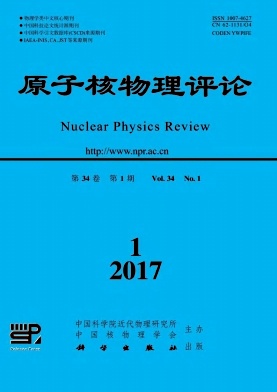|
[1]
|
TWIN P J, NYAKO B M, NELSON A H, et al. Phys Rev Lett, 1986, 57: 811. |
|
[2]
|
SINGH B, ZYWINA R, FIRESTONe R B. Nucl Data Sheets, 2002, 97: 241. |
|
[3]
|
GU J Z, WEIDENMÜLLER H A. Nucl Phys A, 1999, 660: 197. |
|
[4]
|
SARGEANT A J, HUSSEIN M S, PATO M P, et al. 2002, Phys Rev C, 2002, 65: 024302. |
|
[5]
|
WILSON A N, SARGEANT A J, DAVIDSON P M, et al. Phys Rev C, 2005, 71: 034319. |
|
[6]
|
WILSON A N, SINGH A K, HUEBEL H, et al. Phys Rev Lett, 2005, 95: 182501. |
|
[7]
|
WILSON A N, SZIGETI S S, DAVIDSON P M, et al. Phys Rev C, 2009, 79: 014312. |
|
[8]
|
WILSON A N, KORICHI A, SIEM S, et al. Phys Rev Lett, 2010, 104: 162501. |
|
[9]
|
CHIARA C J, SARANTITES D G, MONTERO M, et al. Phys Rev C, 2006, 73: R021301. |
|
[10]
|
WEIDENMÜLLER H A, MITCHELL G E. Rev Mod Phys, 2009, 81: 539. |
|
[11]
|
ZOU Wenhua, TIAN Yuan, GU Jianzhong, et al. Phys Rev C, 2010, 82: 024309. |
|
[12]
|
GU Jianzhong, PENG Bangbao, ZOU Wenhua, et al. Nucl Phys A, 2010, 834: 87c. |
|
[13]
|
GAFFNEY L P, HACKSTEIN M, PAGE R D, et al. Phys Rev C, 2014, 89: 024307. |
|
[14]
|
BREE N, WRZOSEK-LIPSKA K, PETTS A, et al. 2014, Phys Rev Lett, 2014, 112: 162701. |
|
[15]
|
ESTEVEZ AGUADO M E, ALGORA A, AGRAMUNT J, et al. Phys Rev C, 2015, 92: 044321. |
|
[16]
|
VIGEZZI E, BROGLIA R A, D SSING T. Nucl Phys A, 1990, 520: 179C. |
|
[17]
|
SHIMZU Y R, MATSUO M, YOSHIDA K. Nucl Phys A, 2001, 682: 464c; YOSHIDA K, MATSUO M, SHIMZU Y R. ibid. 2001, 696: 85. |
|
[18]
|
STAFFORD C A, BARRETT B R. Phys Rev C, 1999, 60: 051305. |
|
[19]
|
CARDAMONE D, BARRETT B R, STAFFORD C A. Phys Lett B, 2008, 661: 233. |
|
[20]
|
CARDAMONE D, STAFFORD C A, BARRETT B R. Phys Rev Lett, 2003, 91: 102502. |
|
[21]
|
BARRETT B R, BUERKI J, CARDAMONE D, et al, Phys Lett B, 2003, 688: 110. |
|
[22]
|
DZYUBLIK A, UTYUZH V. Phys Rev C, 2003, 68: 024311. |
|
[23]
|
ADAMIAN G G, ANTONENKO N V, JOLOS R V, et al. Phys Rev C, 2003, 67: 054303; ibid. 2004, 69: 054310. |
|
[24]
|
GU J Z. Int J Mod Phys E, 2008, 17: 292. |
|
[25]
|
ABERG S, Phys Rev Lett, 1999, 82: 299. |
|
[26]
|
BERGER J, GIROD M, GOGNY D. Nucl Phys A, 1984, 428: 32c. |
|
[27]
|
BONCHE P, DOBACZEWSKI J, FLOCARD H, et al. Nucl Phys A, 1990, 519: 509. |
|
[28]
|
HARA K, SUN Y. Int J Mod Phys E, 1995, 4: 637. |
|
[29]
|
HARA K, SUN Y, Mizusaki T. Phys Rev Lett, 1999, 83: 1922. |
|
[30]
|
SUN Y, WALKER P, XU F R, et al. Phys Lett B, 2008, 659: 165. |
|
[31]
|
LAURITSEN T, BENET P, KHOO T L, et al. Phys Rev Lett, 1992, 69: 2479. |
|
[32]
|
KRÜCKEN R, DEWALD A, VON BRENTANO P, et al. Phys Rev C, 1996, 54: 1182. |
|
[33]
|
RODRIGUEZ-GUZMAN R R, EGIDO J L, ROBLEDO L M. Phys Rev C, 2004, 69: 054319. |
|
[34]
|
STOITSOV M V, DOBACZEWSKI J, NAZAREWICZ W, et al. Computer Physics Communication, 2005, 167: 43. |
|
[35]
|
YAO J M, BENDER M, HEENEN P H. Phys Rev C, 2013, 87: 034322. |






 甘公网安备 62010202000723号
甘公网安备 62010202000723号 DownLoad:
DownLoad: